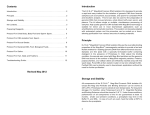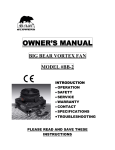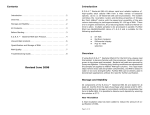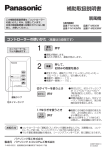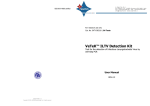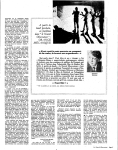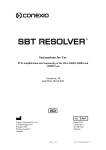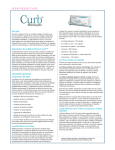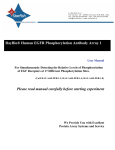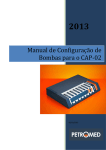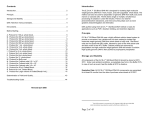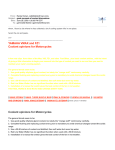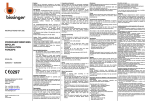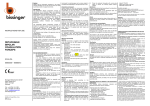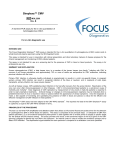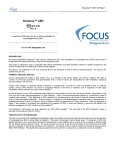Download - LiStarFish
Transcript
Contents Introduction Introduction.. . . . . . . . . . . . . . . . . . . . . . . . . . . . . . . . . . . . . . . . . . . . . . . 2 The Mag-Bind ® Forensic DNA Isolation KF96 Kit is designed to provide a rapid and easy m ethod for the isolation of genom ic DNA from forensic sam ples such as dry blood, buccal swabs, and sperm by using Kingfisher instrum ent. This kit can also be used for the preparation of genom ic DNA from m ouse tail snips, whole blood, buffy coat, serum , and plasm a. High quality genom ic DNA isolated with Mag-Bind technology is suitable for direct use in m ost downstream applications such as am plifications and enzym atic reactions. This system can be easily adapted with autom ated system and the procedure can be scaled up or down, allowing purification from various am ounts of starting m aterials. Principle. . . . . . . . . . . . . . . . . . . . . . . . . . . . . . . . . . . . . . . . . . . . . . . . . . 2 Storage and Stability. . . . . . . . . . . . . . . . . . . . . . . . . . . . . . . . . . . . . . . . 3 Kit Contents. . . . . . . . . . . . . . . . . . . . . . . . . . . . . . . . . . . . . . . . . . . . . . . 3 Before Starting. . . . . . . . . . . . . . . . . . . . . . . . . . . . . . . . . . . . . . . . . . . . . 4 Forensic DNA Protocol. . . . . . . . . . . . . . . . . . . . . . . . . . . . . . . . . . . . . . 4 Protocol For Dried Body, Body Fluid and Sperm Spots .. . . . . . . . 4 Principle Protocol For DNA isolation from Sperm . . . . . . . . . . . . . . . . . . . . . . .5 Mag-Bind® Forensic DNA Isolation KF96 Kit use the reversible binding properties of the Mag-Bind ® param agnetic particles to provide a fast and flexible m ethod for isolating genom ic DNA from different forensic sources. Sam ples are first lysed with a specially form ulated buffer containing detergent in the presence of Proteinase K. After adjust the binding condition, the sam ple was m ixed with Mag-Bind particles and the genom ic DNA was bound to the surface of Mag-Bind m agnetic particles. Proteins, polysaccharides, and cellular debris are efficiently washed away with few wash steps. Pure DNA is then eluted in water or low ionic strength buffer. Purified DNA can be directly used in downstream applications without the need for further purification. Protocol For Buccal Swabs. . . . . . . . . . . . . . . . . . . . . . . . . . . . . . 5 Protocol For Bacterial DNA From Biological Fluids. . . . . . . . . . . . 6 Protocol For Saliva. . . . . . . . . . . . . . . . . . . . . . . . . . . . . . . . . . . . . 6 Protocol For Hair, Nails and Feathers. . . . . . . . . . . . . . . . . . . . . . 7 Determ ination of Yield and Quality. . . . . . . . . . . . . . . . . . . . . . . . . . . . . 7 Troubleshooting Guide. . . . . . . . . . . . . . . . . . . . . . . . . . . . . . . . . . . . . . 8 Storage and Stability Revised June 2009 All com ponents of the Mag-Bind ® Forensic DNA Isolation KF96 Kit except the Proteinase K, can be stored at 22o C-25o C. Once reconstituted in water, Proteinase K m ust be stored at -20 oC. Under these conditions, perform ance of all com ponents of the kit are guaranteed at least 18 m onths. Under cool am bient conditions, a precipitate m ay form in the Buffer TL and MSL. In case of such an event, heat the bottle at 50 oC to dissolve the precipitate. 2 Kit Contents Forensic DNA Protocol Product M1429-00 M1429-01 M1429-02 Purification 1 x 96 4 x 96 20 x 96 Mag-Bind Particles S 1.1 mL 4.2 mL 21 mL Buffer MSL 35 mL 140 mL 700 mL Buffer TL 45 mL 175 mL 875 mL SPM Buffer 36mL 144 mL 3 x 300 mL MP Buffer 20 mL 80 mL 400 mL Elution Buffer 15 mL 60 mL 2 x 150 mL Proteinase K 60 mg 240 mg 1.2 g 4 mL 15 mL 65 mL 1 1 1 Proteinase Storage Buffer User Manual KingFisher 96 Process Pipetting Instruction for KingFisher 96 and M ag-Bind Forensic DNA protocol C A U T I O N ! B u ffe r M S L con tains a chaotropic salt. Ple ase w e ar glove s, an d appropriate e ye w are w h ile perform in g th is proce du re . NOTE: The E.Z.N.A.® Mag-Bind Forensic DNA Isolation Kit is supplied with enough buffer for the standard protocol. However, due to increased volumes called for in some protocols, fewer preparations may be performed. Also, additional buffers can be purchased separately from Omega Bio-Tek. See the Accessories section in the catalog or call customer service for price information Before Starting • Reconstitute Proteinase K with Proteinase Storage Buffer to final concentration at 20mg/ml. Store at -20EC. Vortex vial briefly prior to use. Important SPM Buffer must be diluted with absolute ethanol as follows M1429-00 Add 84 mL ethanol / bottle M1429-01 Add 336ml ethanol/bottle M1429-02 Add 700 mL ethanol / bottle Plate Type Plate Content A 1 Sample/ Lysate according to protocols below. A 2 MP Buffer 500 µl A 3 SPM Buffer 600 µl A 4 SPM Buffer 600 µl B 5 Elution Buffer 100 µl * A= KingFisher 96 DW Plate, B=KingFisher 96 KF Plate • • • • • Add 30ml absolute ethanol Add 120ml absolute ethanol Add 600 ml absolute ethanol Prepare lysate by following the use instruction based on sample type. Add 500 µl MP Buffer to Plate 2. Add 600 µl SPM W ash Buffer to Plate 3. Add 600 µl SPM W ash Buffer to Plate 4. Add 100 µl Elution Buffer to Plate 5. Protocol For Isolation of DNA From Dried Blood, Body Fluids and Sperm Spots Dried blood, body fluids, and sperm samples on filter paper can be processed using the following method. We recommend using OB Specimen Paper (OSP-01 and OSP-02) for spotting blood, This kit can also be used for samples collected by using other specimen collection papers such as FTA cards. 1. Cut or punch out the blood spot (or other sample) from the filter paper. (1ul - 10ul of blood can be used for each spot.) Tear or cut filter into small pieces and place into a microfuge tube. Note: Use 3-4 punched cycles (3mm diameter) for each DNA isolation. 2. Add 100ul Buffer TL and 10ul Proteinase K and mix by vortexing. Incubate for 30-45 minutes at 55o C with occasional mixing. 3. Add 110ul Buffer MSL and incubate at 55o C for 10 minutes. Vortex every 2 min to mix. Prepare FRESH Buffer MP/Ethanol as follows. This mixture can only be stored at room temperature for two weeks. M1429-00 M1429-01 M1429-02 Reagent Volume 4 5. 6. 7. Transfer 200 ìl to a Kingfisher DW Plate. Add 160ìl of Ethanol(96-100 %)l followed by 10ìl of Mag-Bind particles to the KF Deep well plate. This will be Plate 1 in Kingfisher Protocol. Press start on Kingfisher 96 dried blood spots protocol and load plates accordingly. collection. 2. Carefully break or cut off the end part of the swab or brush into a 1.2 ml microcentrifuge tube/ plate and add 400 ìL TL to the tube. Add 20 ìL Proteinase K solution (20mg/ml). Incubate 60 minutes at 56EC. 3. 4. Transfer 290 µl of lysate into a KingFisher Deep Well Plate. Add 300 ìL Buffer MSL to the sample. Mix immediately by vortexing for 30 seconds. Add 400 µl ethanol and 10 µl magnetic beads. This will be plate 1 in the KF protocol. 5. Press start on Kingfisher 96 Buccal Swabs protocol and load plates accordingly. Protocol For Isolation of Genom ic DNA From Sperm This protocol can be used for fresh or frozen semen samples with equal efficiency. Frozen samples must to be thawed thoroughly before use. Note that lysis time will vary depending on the size and density of the source material. Make the following buffer before starting: Buffer SL 200 mM NaCI 20mM Tris-HCl, pH 8.0 20mM EDTA, pH 8.0 4% SDS 1% ß-mercaptoethanol 1. Add 100ìL of sperm to 100ìL of Buffer A in a glass (Corex) centrifuge tube. Vortex for 10 sec at full speed. Only use Corex tubes to prevent attachment of the sperm cells to the tube walls. 2. Add 20 ìL Proteinase K (20 mg/mL)and incubate for 2 hours at 60o C. Invert the tube occasionally to disperse the sample or place on a rocking platform. 3. Add 220 ìL Buffer MSL to the sample and mix by vortexing. 4. Transfer 400 µl sample to a KF 96 Deep Well Plate. 5. Add 270µl absolute ethanol to each sample. 6. Add 10ìl of Mag-Bind particles and mix throughly. This will be Plate 1 in Kingfisher Protocol Press start on Kingfisher 96 Sperm protocol and load plates accordingly. Protocol for Isolation of Bacterial DNA From Biological Fluids: 1. Pellet bacteria by centrifuging 10 minutes at 8,000rpm. 2. Resuspend bacterial pellet with 200 ìL TL buffer. 3. Follow the protocol for dried blood, body fluids and sperm spot (Page 4) from Step 3. Protocol For Isolation of DNA From Salvia: 1. Collect 200 ìL saliva in a 1.5 mL tube/plate contains 200 ìL Buffer MSL and 20 ìl of Proteinase K. 2. Mix the sample throughly by vortexing or pipetting up and down for 20 times. 3. Incubate at 65EC for 30 minutes. 4. Transfer the sample to a KF 96 Deep Well Plate. 5. Optional: If RNA-free DNA is desired, add 10 µl of RNase A (25mg/ml) and incubate at room temperature for 5 minutes. Protocol For Isolation of Genomic DNA From Buccal Swabs: 6. Add 10µl Mag-Bind Particles followed by 290 µl of absolute ethanol. Mix throughly. This will be plate 1 in Kingfisher Protocol. This protocol has been tested for the following swab types: cotton, C.E.P. (Life Science). Typical yields from these swabs are 0.5 - 3 ìg DNA. 7. Press start on Kingfisher 96 Saliva protocol and load plates accordingly. 7. 1. Scrape the swabs firmly against the inside of each cheek 6 -7 times. Air or vacuum dry the swabs for 2 hours after collection. The person providing the sample should not eat or drink for at least 30 minutes prior to the sample 6 Protocol For Isolation of DNA From Hair, Nails and Feathers: Troubleshooting Guide 1. Cut the sample into small pieces (0.5-1 cm) and transfer it to a 1.5 mL centrifuge tube. Tip: For hair, cut from base of hair; for feathers: select the primary feathers. (Large birds, secondary tail or breast feather can be use). 2. Add 400 ìL TL Buffer, 25 ìL Proteinase K and 20 ìL 1M DTT. Mix throughly by vortexing. Incubate 30 min at 60o C with occasional mixing. 3. Transfer 290 µl of lysate into a KingFisher Deep Well Plate without removing insoluable debri. It may be necessary to centrifuge at 4,000 x g to pellet debri.. 4. Add 300 ìL Buffer MSL to the sample. Mix immediately by vortexing for 30 seconds. Add 400 µl ethanol and 10 µl magnetic beads. This will be plate 1 in the KF protocol. 5. Press start on Kingfisher 96 Buccal Swabs protocol and load plates accordingly Determination of Yield and Quality The total DNA yield can be determined by a spectrophotometer using deionized water, Tris-HCl buffer, or Elution Buffer as blank. DNA concentration is calculated as: Problem Likely Cause Suggestions Low DNA yields Incomplete resuspension of magnetic particle Resuspend the magnetic particles by vortexing before use. Inefficient cell lysis due to inefficient mix of buffer MSL and sample Make sure the sample is throughly mixed with BufferMSL. SPM Buffer were not prepared correctly. Prepare the SPM Buffer by adding ethanol according to instruction Lose of magnetic beads during opetation careful not remove the magnetic beads during the operation Inefficient cell lysis due to decrease of activity of proteinase k Add more proteinase K solution. No DNA eluted SPM Wash Buffer Concentrate not diluted with absolute ethanol. Prepare SPM Wash Buffer Concentrate as instructed on the label. Problem with downstream application Insufficient DNA was used 1. Use more stating material 2. Quantify the purified DNA accurately and use sufficient DNA. Excess DNA was used for downstream application [DNA] = (Absorbance2 6 0 ) x (0.05 ìg/ ìL) x (Dilution factor) The quality of DNA can be assessed by measuring absorbance at both 260 nm and at 280 nm. A ratio of (A2 6 0 /A2 8 0 ) of 1.7-1.9 corresponds to 85%-95% purity. Make sure to use correct amount DNA. Expected yields vary with both amount, and type of tissue used. 30 mg of fresh tissue will yield 10-40 ìg DNA with two elutions (each 200 ìL). Distribuito in ITALIA da Li StarFish S.r.l. Via Cavour, 35 20063 Cernusco S/N (MI) telefono 02-92150794 fax 02-92157285 [email protected] www.listarfish.it 8




